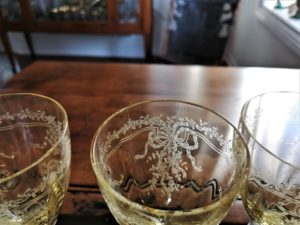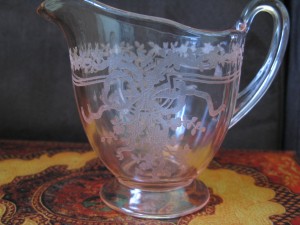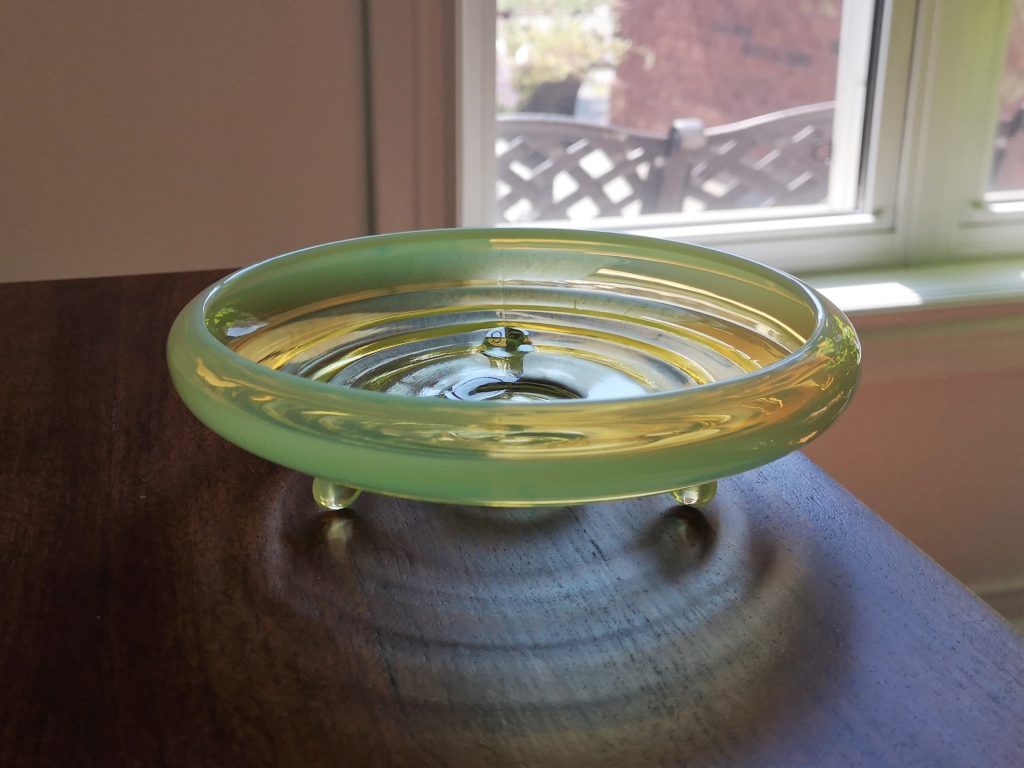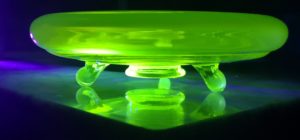Fostoria Diadem Topaz Glass Bowl – Kashmir Etch
14 Sunday Feb 2021
Posted in Fostoria
14 Sunday Feb 2021
Posted in Fostoria
02 Friday Oct 2020
Posted in Fostoria
Tags
Bows, Creamer, Floral, June, Pink, Plate Etched, Wine Glass, Yellow Glass
Was up in St. Jacobs at the St. Jacobs Antique Market a couple weekends ago and came across a quartet of these pretty stems. They are 3 ounce wine glasses.
The etch is #279 – June and the line is #5098 (patented in 1928). A copy of the patent is available for review in the gallery of the Elegant and Everyday Glass Forum.
The depth of the etch is interesting. Three of the glasses are lightly etched and the fourth shows much heavier etching. I have tried to show this in the images. The larger photo has the lighter etching. 
Such a pretty yellow.
__________________________________________________________________
January 17, 2012
I had the sugar at one point but sold it. June is a very pretty etch. This is in pink and it comes in blue, two yellows and clear as well. This etch is similar to another of Fostoria’s patterns – Romance. I gather that the pink and blue are the most popular colours for collectors. This is the only piece I have of this etch. Pretty, very romantic.
29 Saturday Aug 2020
Posted in Fenton
Tags
Bowl, Colored Glass, Coloured Glass, Line 100, Opalescent Glass, Ring, Ringed, Rings, Topaz Glass, Vaseline Glass, Yellow Glass
 This little bowl has a very pretty colour. I don’t know Fenton’s colour chart at all, but my understanding that this is their colour Topaz. I have this great book – Colors & Patterns of Depression Era Glassware by Doris Yeske & Lyle Fokken – which refers to Fostoria’s ‘yellow’ glass being called ‘Topaz’.
This little bowl has a very pretty colour. I don’t know Fenton’s colour chart at all, but my understanding that this is their colour Topaz. I have this great book – Colors & Patterns of Depression Era Glassware by Doris Yeske & Lyle Fokken – which refers to Fostoria’s ‘yellow’ glass being called ‘Topaz’.
In fact, Fenton is a company that is not well represented in my collections, or purchases. Don’t know why. I tend to lean toward Heisey, Cambridge or Fostoria glass lines and etches.
The brightness of the colour, and the opalescence around the rim caught my eye. However the pattern is pretty too. The photos may not show this well – but there are rings in the glass. I don’t know if the pattern was named “Ring’ or ‘Rings’ or ‘Ringed’ by Fenton but I see online that it is often referred to by one of those names.
This piece does glow brightly under a blacklight. These bright green pieces are often referred to as Vaseline glass.
The Encyclopedia of Glass by Mark Pickvet defines ‘Vaseline Glass’ as follows (p. 269):
“Glass made with a small amount of uranium oxide (usually 1-2%) that imparts a light greenish-yellow color……Vaseline glass was first made by the Romans; however it was not used in glass production in any quantity until the mid-nineteenth century. The term ‘Vaseline’ was not used until about 1937. Note  that the English usually refer to Vaseline glass as ‘Lemonescent’ while it has also been called canary, yellow, uranium, topaz, magic, Canaria, Chameleon, Anna Yelloow, Annagrun, and Lenora Green.’
that the English usually refer to Vaseline glass as ‘Lemonescent’ while it has also been called canary, yellow, uranium, topaz, magic, Canaria, Chameleon, Anna Yelloow, Annagrun, and Lenora Green.’